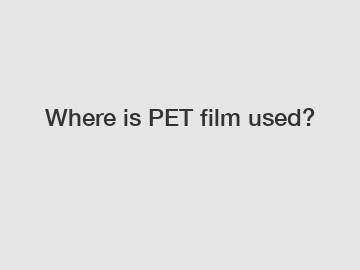Mar. 27, 2024
In today's world of technological advancements and innovation, PET film has become a ubiquitous material that is used in a wide range of applications. PET, which stands for polyethylene terephthalate, is a type of plastic that is known for its exceptional clarity, strength, and durability. It is a versatile material that is used in various industries for its unique properties and advantages.
One of the most common uses of PET film is in the packaging industry. PET film is used to make clear plastic bottles, containers, and packaging materials that are used to store and protect food, beverages, pharmaceuticals, and other products. The high clarity and strength of PET film make it an ideal material for packaging applications, as it allows consumers to see the contents of the package while also providing protection from external elements.
PET film is also used in the printing industry, where it is used to make printable substrates for labels, decals, and signage. The smooth surface of PET film allows for high-quality printing and graphics, making it a popular choice for companies looking to create eye-catching and durable printed materials. PET film is also commonly used in the production of flexible electronics, such as touchscreens, displays, and solar panels. Its high tensile strength and heat resistance make it an ideal material for applications that require flexibility and durability.

In addition to packaging and printing, PET film is used in the automotive industry for various applications. PET film is used to make protective films for car windows, headlights, and paint protection films that protect the exterior of vehicles from scratches, chips, and fading. It is also used in the manufacturing of interior components, such as dashboard panels, door trims, and seat covers, due to its durability and resistance to heat and moisture.
Another industry that relies heavily on PET film is the medical industry. PET film is used to make medical packaging materials, such as blister packs, pouches, and trays, that are used to store and transport medical devices, supplies, and equipment. The high barrier properties of PET film help to protect medical products from contamination and deterioration, making it an essential material for the healthcare sector.
PET film is also used in the construction industry for various applications. It is used to make protective films for windows, doors, and other surfaces during construction and renovation projects. PET film is also used as a vapor barrier in insulation materials to help regulate temperature and moisture levels in buildings. Its strength and durability make it well-suited for use in construction applications where protection and longevity are key considerations.
Additionally, PET film is used in the textile industry for the manufacturing of synthetic fibers and fabrics. PET fibers can be used to create lightweight, breathable, and moisture-wicking fabrics that are commonly used in sportswear, activewear, and outdoor gear. The durability and colorfastness of PET fibers make them ideal for applications that require long-lasting performance and aesthetic appeal.
In conclusion, PET film is a versatile material that is used in a wide range of industries and applications. Its exceptional clarity, strength, and durability make it an ideal choice for packaging, printing, electronics, automotive, medical, construction, and textile applications. As technology continues to advance and new uses for PET film are discovered, its importance and relevance in various industries will only continue to grow. Whether you realize it or not, PET film plays a crucial role in our daily lives and will continue to do so for the foreseeable future.
For more information, please visit protective film suppliers, pe surface protective film manufacturers, mirror surface protection.
Previous: Where is surface protection film used?
Next: Choosing the Best Cornstarch Biodegradable Resin: A Comprehensive Guide
If you are interested in sending in a Guest Blogger Submission,welcome to write for us!
All Comments ( 0 )